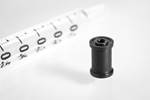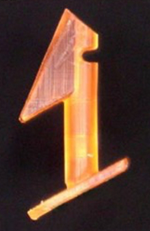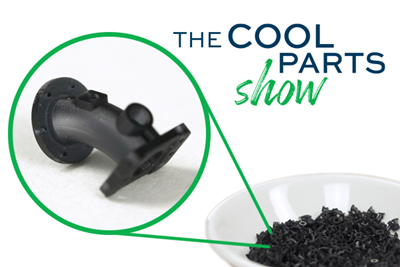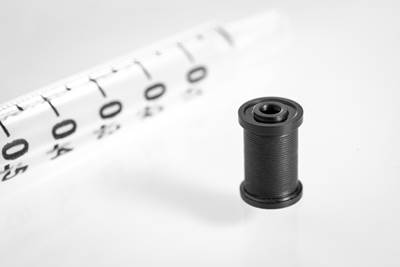As parts in industries such as medical and electronics are getting smaller, they’re becoming more difficult to machine or mold, and even more difficult to prototype. Prototyping has been a major application for 3D printing, but only recently has it been able to achieve microscale accuracy. Peter Zelinski and I discuss the technology that makes micro 3D printing possible, as well as other applications for these systems. Listen to the episode above, or read on for the show notes and transcript.
Transcript
Peter Zelinski 00:05
On this episode, how additive manufacturing is realizing new possibilities for components at the extremes of size range: very, very tiny parts; very, very big parts. Additive at the extremes. That’s coming up on AM Radio.
Julia Hider 00:30
This episode of The AM Radio podcast is brought to you by PT Expo, the show for North American plastics professionals. Join Additive Manufacturing Media and sister brand Plastics Technology for the first ever edition of this event in March of 2022. Find more information at plasticstechnologyexpo.com.
Peter Zelinski 00:50
I’m Pete Zelinski, welcome to AM Radio, our podcast all about additive manufacturing. I’m here with Julia Hider. Hey, Julia.
Julia Hider
Hey, Pete.
Pete Zelinski
So I’ve got this thing I want to talk about today. So there are these advantages of additive manufacturing, right. And we kind of like they’re the ones we’re kind of familiar with. And they have to do with part complexity, geometric complexity, and that gets you to lightweighting. And that gets you to assembly consolidation. But there is this other advantage of additive manufacturing that I think is underappreciated. And, and it has to do with scale, it has to do with more options, and even greater simplicity at part sizes that get really challenging. And it’s true for really, really small parts, and really, really big parts. And in thinking about it, like, I think the reasons are kind of different at those two extremes, but also kind of related in some ways. I thought we could have a conversation where we kind of explore that and unpack that. And you’re a good person to talk about that with because you’ve had some experience with really, really little 3D printing, right?
Julia Hider 01:59
Yeah, I’ve written a couple of articles about micro 3D printing. It’s becoming a big deal in, like, the medical field, and especially for electronics with things are getting smaller and smaller and more things have batteries and electrical components. But first, when talking about micro machining and micro 3D printing, I think it’s useful to define what we mean by micro. So people have different interpretations of that term. But typically, I think we’re talking about things that are measured in centimeters, or millimeters or microns.
Peter Zelinski 02:34
Like big enough to see. But still small enough, you have to squint to see the details.
Julia Hider 02:39
Yeah, yeah, that’s, that sounds about right. And then another thing that people have pointed out to me in writing about this is that it can refer to parts that are, you know, at that scale, or maybe a larger part that has features at that scale, but the whole part is bigger or larger parts that have micro tolerances.
Peter Zelinski 02:58
And so the challenge of this is that you get that small, and the things we usually do to make parts get hard to do. Machining would require very, very tiny tools that require special considerations or special skill to work with, or molding would require very small precise molds that are on a millimeter per millimeter basis are kind of way more expensive than conventionally sized molds just because of the difficulty of making them. Talk about 3D printing the answer to that?
Julia Hider 03:33
Yeah, so a lot of micro 3D printing systems are resin based systems. I wrote about the Fabrica 2.0 from Nano Dimension, which is a DLP system. So it’s the optical system that determines the resolution and how small the parts can be. So the Fabrica 2.0 has an optical system that enables at pixel size of 1.9 microns in a layer thickness of one micron, so definitely in the scale that we’re talking about here. And then another factor that comes into play with micro 3D printing is sort of the machine construction itself. So in order to produce tiny, precise parts with tiny precise features, the machine needs to be able to make tiny, precise movements. So the Fabrica 2.0 has specialized servo elements and controls that enable movement at this level. And according to the company, the margin of error on the machines movement is 100 nanometers, which is pretty precise.
Peter Zelinski 04:27
And so it touches on this thing we keep encountering — like additive manufacturing, 3D printing, it’s a big term that covers a lot of stuff and, and offhand from a surface level, it’s a little surprising that 3D printing is an answer to the challenge of really tiny, really precise parts, because your first view of 3D printing, like, you imagine FDM or maybe even imagine, like, powder bed fusion, and these are processes that involve melting. And if a melted material has to solidify, then just, like, where the fluid goes and where the melt pool goes. And that introduces a level of variability that doesn’t allow for the kind of precision we’re talking about. But 3D printing is way bigger than that. And when you talk about these digital light processing approaches to 3D printing, like yeah, it’s a field of light that solidifies a resin. And so yeah, then you could apply to that. We do have really precise optics — that’s a thing that exists. And the machine tool industry has worked out really precise motion control, we can apply that too, and so it does produce this, this really accessible, really reliable solution to getting to really, really tiny features without needing tiny tools or tiny cutting or tiny molding. I was first awakened to this learning about Boston Micro Fabrication, visiting them seeing the kind of parts they’re making. They were making these tiny, tiny, tiny electrical connectors that otherwise would have to be molded. Or they were, they were, they were researching these tiny glaucoma stents. My colleague Julia is wincing, but these to help people with glaucoma these little…
Julia Hider 06:19
I’m very squeamish. I’m sorry.
Peter Zelinski 06:23
Um, but it’s a, it’s a very tiny, precise polymer part that otherwise would be this machined metal object that was very difficult to make. Have you had a conversation with, with a user with an application?
Julia Hider 06:35
Yes. So I wrote an article that was actually for Modern Machine Shop, but we’ll link to it here. They’re called Accumold. And they’re a shop that specializes in micro injection molding. So one of the biggest challenges they’ve had is prototyping, you know, they make micro injection molds for plastic parts. And it’s really difficult to do the micro machining for those molds. And traditionally, they haven’t had any other processes for prototyping these parts. You know, prototyping has been a big application for 3D printing. But 3D printing hasn’t always been able to achieve the micro scales that Accumold needed. So when they were prototyping parts, their only option was to use the same processes that they use for production and machine these tiny molds, and they’d machine multiple versions of them that sometimes only had a few microns a difference. But now that micro 3D printing technology is advanced enough, Accumold got a Fabrica 2.0 that they can use for prototyping. And it’s been really successful and helping them speed up that process and making it much easier for them.
Peter Zelinski 07:37
Can we pause there for a second? Because that’s, that’s huge. Like, that is a huge win for micro 3D printing. Because design requires prototyping, there’s only so much you can do in the digital realm. When you’re designing, you get to a point where your ability to refine the part and get it just perfect sometimes requires you make part after part after part to get it right. And if the manufacturing process is as challenging as microscale manufacturing usually is, it inhibits your ability to prototype. So how many tiny, tiny things do we have out in the world that are just not designed to the extent they could be because the prototyping freedom was so limited, and you’re describing this case here with Accumold. They are now free to do that just keep printing bunches of versions of these little things until they get what they want. If they go farther than that, is there any kind of like tooling or production application that they found?
Julia Hider 08:31
Yeah, so that would definitely be the next step here. So as far as using micro 3D printing for production, one option is to just use the micro 3D printer and print a bunch of parts. But another option is to micro 3D print the mold tooling itself. And this is something that Nano Dimension has worked on specifically, like they developed a special polymer resin that’s reinforced with nanoparticles like glass and ceramic and zirconia. So it’s designed to be stronger and more stable, so it can withstand the higher temperatures and pressures of injection molding. And this is something that Accumold is testing out now. They said that the 3D printed mold inserts don’t need much — if any — processing, which is a huge advantage. But they’re trying to figure out what the limits of the 3D printed molds are. Ultimately, it depends on a lot of factors like the materials being used, or how delicate the features are, and the mold’s accuracy. But they said it could range from anywhere between 10 to 1,000 shots. So that’s not commercial production levels yet, but that’s something that they’re working on. And you also mentioned tooling, but tooling in a different way is that Accumold is printing, you know, micro fixtures and end effectors because they do machining and sub assembly and packaging for the tiny parts that they’re making. So all of the fixtures and effectors and other tooling that they use needs to be really tiny and accurate as well. So that’s been a good application for the micro 3D printer as well.
Peter Zelinski 10:00
All right, let’s, let’s pause here and take a break and then, and then after that like let’s go big. So here’s, here’s our minute microscopic look at micro 3D printing, like we’re now going to take big picture view of, like, huge scale 3D printing. All right.
Related Content
ActivArmor Casts and Splints Are Shifting to Point-of-Care 3D Printing
ActivArmor offers individualized, 3D printed casts and splints for various diagnoses. The company is in the process of shifting to point-of-care printing and aims to promote positive healing outcomes and improved hygienics with customized support devices.
Read MoreQ&A With Align EVP: Why the Invisalign Manufacturer Acquired Cubicure, and the Future of Personalized Orthodontics
Align Technology produces nearly 1 million unique aligner parts per day. Its acquisition of technology supplier Cubicure in January supports demand for 3D printed tooling and direct printed orthodontic devices at mass scale.
Read MoreCopper, New Metal Printing Processes, Upgrades Based on Software and More from Formnext 2023: AM Radio #46
Formnext 2023 showed that additive manufacturing may be maturing, but it is certainly not stagnant. In this episode, we dive into observations around technology enhancements, new processes and materials, robots, sustainability and more trends from the show.
Read More3D Printing with Plastic Pellets – What You Need to Know
A few 3D printers today are capable of working directly with resin pellets for feedstock. That brings extreme flexibility in material options, but also requires greater knowledge of how to best process any given resin. Here’s how FGF machine maker JuggerBot 3D addresses both the printing technology and the process know-how.
Read MoreRead Next
Micro 3D Printing for Tiny Connectors: The Cool Parts Show #20
Microscale additive manufacturing offers an alternative to micromolding and micromachining. On this episode of The Cool Parts Show, 3D printed electrical connectors are our smallest cool part yet.
Read MoreThree Elements of a Micro 3D Printing Platform
Micro 3D printing, aided by advances in optics, machine design and materials, gives companies the capability to print production runs and produce micro mold inserts without micromachining.
Read MoreCan Microscale 3D Printing Reduce Surgeries for Glaucoma Sufferers?
Boston Micro Fabrication (BMF) is exploring this promise. Eye stents are made of metal today. Fine-detail additive manufacturing can enable polymer instead, improving patient experience.
Read More





















